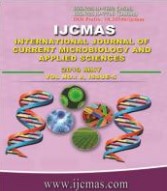


 National Academy of Agricultural Sciences (NAAS)
National Academy of Agricultural Sciences (NAAS)

|
PRINT ISSN : 2319-7692
Online ISSN : 2319-7706 Issues : 12 per year Publisher : Excellent Publishers Email : editorijcmas@gmail.com / submit@ijcmas.com Editor-in-chief: Dr.M.Prakash Index Copernicus ICV 2018: 95.39 NAAS RATING 2020: 5.38 |
Rain fed lowland traditional variety rice cultivation in Andaman and Nicobar islands in acidic soils with low inherent fertility is done with minimal use of fertilizer and thus have low yields and profits. Use of hybrids and balanced fertilization especially nitrogen (N) may improve the situation. In this context, a field study was made during 2016 rainy season to assess the performance of 8 hybrids (including a variety) in main plots and four N rates (0, 50, 100 and 150 kg/ha) as sub-plot treatments. Experiment was laid out in split plot design with three replications. Results based on grain yield (t/ha) and net income (Rs/ha) revealed that rice hybrid ‘KPH-459’ (3.32 t/ha and Rs. 14585) and 100 kg/ha N fertilization (3.22 t/ha and Rs.12105) as the best treatments. Cultivar and nitrogen interaction indicated that ‘KPH-459’ with 50 kg N fertilization is as good as ‘PR-14019’, ‘PR-14112’ hybrids and better than ‘WGL-14’ variety receiving highest N (150 kg) for profits. Cultivation of ‘KPH 459’ hybrid with 100 kg N gave the significantly higher profits (Rs. 29607) than all other cultivars and N combinations. Nitrogen uptake followed the trend of grain yields, however all N use efficiency indices (Physiological efficiency, Apparent recovery and Utilization efficiency) except agronomic efficiency have highest values high at 50 kg N. N response of rice crop and 6 cultivars was linear (KPH-459’ and ‘PR-14019’ have quadratic response). Replacement of current rice varieties with ‘KPH-459’ hybrid with high soil N dependence requiring low N dose (50 kg/ha) could be rewarding for Andaman and Nicobar Islands climate having high rain fall and low soil fertility and fertilizer use by farmers.
 |
 |
 |
 |
 |